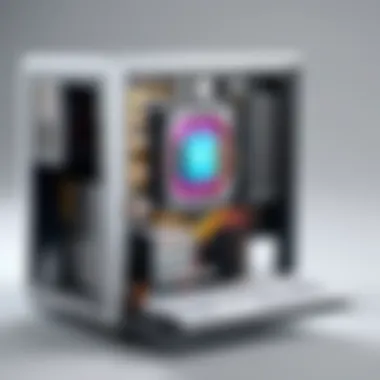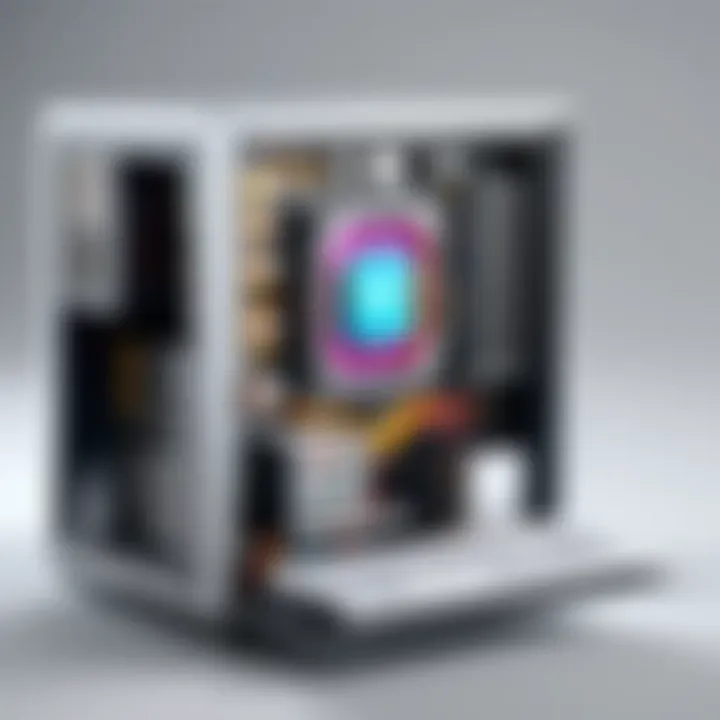Exploring the Depths of Computer Technology


Intro
In today's fast-paced world, computers are no longer just tools; they are the very backbone of our digital existence. From the way we communicate to how we manage data, their significance cannot be overstated. As technology evolves at breakneck speed, understanding the fundamental aspects of computers—such as their architecture, applications, and the trends shaping their future—is more crucial than ever. This article aims to break down the complex workings of computers, presenting a clear and insightful perspective to both enthusiasts and professionals.
Technology Insights
The landscape of technology is in constant flux, and computers serve as a compelling lens through which we can examine these changes. To truly grasp the depth of their impact, let’s look at some recent trends and innovations.
Latest Tech Trends
The surge of artificial intelligence (AI) has profoundly influenced how computers function today. From personal assistants like Siri to predictive algorithms on e-commerce sites, AI is not just a buzzword; it is fundamentally reshaping our interactions with technology. Edge computing also stands out as a game-changer. This technology shifts processing closer to data sources, enhancing speed and efficiency—a critical factor for applications demanding real-time data.
- Cloud Computing: With services like Amazon Web Services and Microsoft Azure, the ability to access vast computational resources has never been easier. More businesses embrace hybrid models to balance on-premise and cloud solutions.
- Quantum Computing: Though still in its infancy, quantum computing promises to solve complex problems faster than traditional computers. Companies like IBM and Google are making strides in this area, with implications that could revolutionize fields like cryptography and materials science.
Innovation in Tech
Innovation doesn’t stop at hardware; software plays a pivotal role in defining the user experience. The rise of open-source platforms has democratized software development, allowing more individuals to contribute to projects and share solutions. This collaborative spirit drives rapid iterations and improvements that benefit everyone.
"The best way to predict the future is to invent it." - Alan Kay
In particular, machine learning algorithms are integrating into everyday software, from diagnostics in medical applications to enhanced recommendation systems on streaming platforms. The potential for these technologies goes far beyond convenience; they could actually redefine entire industries.
Product Reviews
When discussing technology trends, one cannot overlook the latest devices that have hit the market. From laptops to peripherals, these products have revolutionized how we use computers.
- Apple MacBook Air (M2): With its new chipset, the MacBook Air offers unparalleled performance and efficiency, making it a favorite among professionals and students alike.
- Dell XPS 13: Renowned for its stunning display and compact design, this laptop continues to dominate the portable computing scene.
Emerging products like the ASUS ROG Flow Z13 have changed the game by blending the power of gaming laptops with the versatility of tablets. This hybrid approach caters to a broad audience, from gamers to creators.
Finale
The world of computers is intricate and ever-evolving. Keeping abreast of these trends isn't just about staying relevant; it’s about understanding the future direction of technology. As we continue to survey the digital landscape, it becomes clear that our relationship with computers is set to deepen, offering us both challenges and exciting new possibilities.
The Evolution of Computers
The journey of computers, from their rudimentary beginnings to their current state of sophistication, is an intriguing tale of innovation, adaptation, and impact on society. Understanding the evolution of computers is crucial to grasp how these devices have transformed every facet of our lives. By delving into the historical milestones, we can appreciate not just the technological advancements but also the human ingenuity that propelled these changes.
Early Mechanical Innovations
The path to modern computing began long before the term "computer" was even coined. Early mechanical innovations laid the groundwork for what would eventually evolve into sophisticated machines.
Devices such as the abacus, dating back to ancient times, provided a means for humans to perform arithmetic calculations efficiently. Fast forward to the 17th century, and we see figures like Blaise Pascal inventing the Pascaline, a mechanical calculator that could add and subtract.
In the following century, Gottfried Wilhelm Leibniz further refined these concepts with his own design capable of multiplication and division. These inventions were not just technical marvels; they were pivotal in shifting humanity's approach to problem-solving and mathematics.
"In every machine, there’s a touch of genius that helps us decode complexity."
As we look deeper into the 19th century, Charles Babbage emerges with concepts of the Analytical Engine, often hailed as the first mechanical computer. Although it was never completed in his lifetime, Babbage’s vision included features we recognize today, like an arithmetic logic unit and even a form of programming through Ada Lovelace's notes.
The Birth of Electronic Computers
The transition from mechanical to electronic computers marked a significant leap in computational capabilities. The 20th century witnessed a surge of innovation driven by the requirements of World War II. The Colossus, developed to decipher encrypted messages, was the first electronic digital computer. Its introduction to the field challenged the notion of computation entirely.


Following that, ENIAC (Electronic Numerical Integrator and Computer) arrived in 1945, fully embracing the electronic age. This colossal machine could perform vast calculations at unprecedented speeds. Importantly, it served as a proof of concept that electronic components could significantly reduce computation time when compared to their mechanical predecessors.
Then came the transistor, invented in the late 1940s, which ushered in a new era of computing. This small but powerful device allowed computers to become more compact and energy-efficient, paving the way for the rapid advancement of technology.
The Personal Computer Revolution
In the late 20th century, we entered an era that would democratize computing—the personal computer revolution. The introduction of the Apple I by Steve Jobs and Steve Wozniak in 1976, followed by the IBM PC in 1981, made computers accessible to average consumers. This accessibility simultaneously fostered a creative explosion in software development that would change the landscape of technology and business.
People began using computers not just as tools for professionals, but as a part of their everyday lives. Word processors, spreadsheets, and games transformed how individuals approached work and leisure.
As personal computers became ubiquitous, the internet began to rise, further entwining technology with daily living. With innovations like graphical user interfaces, the barrier to computing further reduced, making it less intimidating for non-technical users. This social shift resulted in a truly interconnected world, ultimately paving the way for what we know as the modern digital age today.
Understanding Computer Architecture
Computer architecture is a fundamental pillar in grasping the depth of computation. It lays the groundwork for how computers process information, manage resources, and execute tasks. Without an understanding of architecture, one can feel like they're trying to navigate a maze without a map. Essentially, computer architecture involves how the various components of the computer interact, their configurations, and how each can impact performance.
Key Components and Their Functions
Each element of computer architecture plays a crucial role in the efficiency and functionality of the system. Understanding these components can help users make informed decisions about building or upgrading systems based on their needs.
Central Processing Unit
The Central Processing Unit (CPU) is often dubbed the brain of the computer. Its significance lies in its ability to process instructions at lightning speed. A key characteristic of a CPU is its clock speed, measured in gigahertz (GHz), which directly translates to how quickly it can execute instructions. A higher clock speed typically means better performance.
However, performance depends not just on speed. The architecture of the CPU, such as whether it's single-core or multi-core, matters. Multi-core CPUs can perform multiple tasks simultaneously, making them a popular choice for heavy multitasking or gaming. A unique feature of many modern CPUs is their use of hyper-threading, which allows a single CPU core to act like two virtual cores, enhancing performance in specific situations.
While a powerful CPU is beneficial, it can also be a double-edged sword. Higher performance CPUs tend to consume more power and generate more heat. Thus, balancing performance with thermal management is an ongoing challenge for designers.
Memory and Storage Solutions
Memory and storage solutions are crucial for enabling quick access to data, influencing a system's capability to run applications efficiently. The primary types of memory include Random Access Memory (RAM) and various forms of storage such as Hard Disk Drives (HDD) and Solid State Drives (SSD).
RAM is fast and allows the CPU to quickly retrieve data, which makes it a key characteristic that directly enhances performance. Storage solutions, particularly SSDs, are becoming more popular due to their unrivaled speed over traditional HDDs. An SSD can drastically decrease boot times and the launch speed of applications.
However, SSDs are typically more expensive per gigabyte than HDDs, leading to a trade-off between speed and storage capacity. Users may find themselves having to consider personalized needs when choosing between these options for optimal performance according to their specific usage scenarios.
Input and Output Devices
Input and output devices bridge the human-computer interaction. Devices like keyboards and mice serve as input, while monitors and printers handle output. One critical aspect is user experience; without efficient input and output devices, even the most robust computer system falls short in usability. Ergonomics, for instance, in keyboard design, impacts how comfortably a user can interact with their device over extended periods.
Another compelling element is the rise of touchscreens and voice recognition technologies, allowing for more intuitive and seamless interaction. These advancements offer greater accessibility but can come with challenges in precision, especially for tasks requiring finer control.
Operating Systems: The Linchpin of Functionality
Operating systems (OS) facilitate communication between the hardware and software of a computer. They're the backbone of computational tasks, orchestrating processes, managing memory, and ensuring user interfaces are functional. Common OS examples like Windows, macOS, and Linux provide distinct experiences based on their architecture and user bases.
Software and Applications Landscape
The software landscape encompasses everything from operating systems to applications that tip the scales toward a computer's functionality. Software determines how users leverage technology in daily life, impacting other sectors such as business, education, healthcare, and entertainment. This pragmatism enhances the overall user experience, highlighting the significance of distinguishing software's architecture and its myriad applications.
Technical Specifications and Performance Metrics
In the vast and intricate realm of computers, understanding technical specifications and performance metrics is crucial. This knowledge forms the backbone of what makes a computer tick and can significantly influence both buying decisions and practical usage. With countless options available, knowing how speed, efficiency, and capability are quantified ensures that tech-savvy individuals make informed choices.
Technical specifications often consist of a variety of factors, including processor speed, memory capacity, graphics capabilities, and storage solutions. These elements paint a clearer picture of a computer's overall performance. Grasping these concepts not only aids in selecting the right device but also helps in troubleshooting and optimizing existing hardware.


Measuring Speed and Efficiency
Speed and efficiency are at the core of a computer’s performance metrics. Evaluating these elements allows users to determine how well a machine will handle demanding tasks.
Processor Speed and Benchmarking
Processor speed, often expressed in gigahertz (GHz), denotes how many cycles a CPU can perform per second. This metric is crucial for gauging a computer's capacity to process tasks swiftly. For instance, a higher GHz rating usually indicates better performance, especially when running multiple applications or intense software.
Benchmarking tools provide a standardized way to assess processor performance by simulating workloads and measuring results. Software like Cinebench or Geekbench allows comparisons between different CPUs, helping consumers make smarter decisions. The key characteristic of this approach lies in its ability to capture real-world performance, making it clear why this becomes a popular choice for buyers.
However, it's essential to consider that processor speed is not the sole determinant of a computer's performance. High clock speed doesn’t necessarily equate to better overall functionality if paired with inadequate memory or graphics. Therefore, while processor speed remains a significant factor in performance metrics, it must be viewed alongside other components for a more accurate evaluation.
Memory Capacity and Performance
Memory, particularly RAM, is critical for a computer’s multitasking and application handling ability. When discussing memory capacity, the context centers on how much temporary data a system can hold while operating. A higher RAM capacity enables users to run more applications simultaneously without experiencing lag.
The unique feature of memory performance stems from its impact on speed. Faster RAM can significantly affect overall responsiveness, particularly in systems that demand quick access to data. This characteristic makes RAM a focal point in performance assessment, particularly for gaming or content creation, where swift data retrieval is necessary.
When comparing systems, the balance of memory size and speed becomes evident in how smoothly a computer operates. It’s beneficial to understand that while ample memory leads to better future-proofing, there are trade-offs in investment. Users must consider what they are truly using their machines for before splurging on exorbitant memory capacities.
Evaluating Graphics and Multimedia Capabilities
Graphics capability plays a pivotal role, particularly in gaming, graphic design, and video editing. The measurement often focuses on GPU performance, which can differ vastly across devices. High-end GPUs provide a smoother experience in rendering graphics and processing multimedia content, while integrated graphics may suffice for basic tasks. Evaluating these needs ensures users select computers that can handle their specific workloads efficiently.
Storage Solutions: Tradition vs. Innovation
In the storage arena, a tug-of-war exists between traditional hard disk drives (HDD) and the modern solid-state drives (SSD). Each has its unique strengths and weaknesses. HDDs typically offer larger capacities at a lower cost, making them a choice for extensive data storage. However, SSDs boast significantly faster read and write speeds, which translates to quicker boot times and application launches.
This divergence leads to a growing trend where many systems now incorporate a combination of both – utilizing SSD for operating systems and applications while relying on HDD for larger file storage. Understanding these storage dynamics helps users leverage the best of both worlds and optimize their computing setups efficiently.
The Role of Computers in Various Industries
Computers have woven themselves into the very fabric of modern industry, acting as indispensable tools that enhance efficiency and drive innovation. Their versatility allows them to adapt to the requirements of various sectors, from healthcare to education and business. As we explore the significance of computers in these fields, it becomes clear that their role goes beyond mere functionality, transforming workflows, improving service delivery, and shaping the future of work itself.
Healthcare Innovations
In the realm of healthcare, computers stand as the backbone of advancements that bolster patient care and streamline operations. Electronic health records (EHR) have replaced traditional paper notes, allowing for real-time data sharing and improved coordination among healthcare providers. This move not only enhances patient safety but also greatly reduces the likelihood of medical errors.
Moreover, with the advent of telemedicine, computers have made it possible for patients to consult doctors remotely, making healthcare more accessible. Picture someone living in a remote area having the ability to see a specialist without the hassle of long travel. This access is a game-changer, especially in times of crisis, as seen during the COVID-19 pandemic.
"Computers in healthcare not only save time but also save lives, enhancing the patient experience while alleviating the burden on medical staff."
Artificial Intelligence (AI) is also making its mark, with algorithms now analyzing patient data to predict health risks and suggesting personalized therapies. One notable application is IBM’s Watson, which helps oncologists tailor treatment plans based on individual patient records, showcasing the unparalleled promise of computers in medicine.
Computers in Education
The educational landscape has dramatically shifted due to computer technologies. From elementary schools to universities, computers function as crucial instruments in facilitating learning. With online platforms gaining traction, such as Coursera and Khan Academy, education has become more democratic and globally accessible than ever. The integration of computers allows students to engage with material at their own pace, fostering a deeper understanding of the subject matter.
Additionally, classrooms equipped with advanced technology provide interactive learning experiences. Tools like smartboards and educational software transform traditional teaching methods, stimulating student engagement and comprehension.
However, it's vital to acknowledge the digital divide that still exists. Not every student has equal access to computers or the internet, causing gaps in educational opportunities. Hence, while computers have the potential to elevate learning experiences, ensuring equitable access remains a pressing challenge.
Transforming Business Operations


In the business world, computers have revolutionized operations, enhancing not just productivity but also decision-making processes. Data analytics software allows companies to sift through vast amounts of information, uncovering insights that drive strategies and improve customer satisfaction. Whether it’s using SAP for enterprise resource planning or Microsoft Excel for basic data analysis, the tools are endless.
Furthermore, automation is reshaping the current business landscape. Many firms now rely on computers for supply chain management, inventory tracking, and customer service systems, reducing human error and optimizing efficiency. A prime example would be how Amazon employs advanced algorithms to manage stock levels, ensuring items are readily available, thus keeping customers happy.
Still, there's the human aspect to consider. Decreasing tasks means reimagining roles within organizations. Employees may need to adapt by learning new tools and technologies, fostering a culture of continuous improvement and adaptability. In the end, while computers play a pivotal role in transforming operations, the adaptation of the human workforce is equally crucial in harnessing their full potential.
In summary, the influence of computers across various industries is profound. They not only streamline processes but also unlock new possibilities that were once thought unattainable. However, as we continue to integrate these technologies, addressing accessibility and workforce adaptation challenges will remain imperative for maximizing their benefits.
Current Trends Shaping Computer Technology
In the fast-paced realm of computer technology, staying informed about current trends is crucial for anyone hoping to grasp the future landscape of digital solutions. These trends not only redefine how we use technology but also influence various sectors from healthcare to education. While several on-going advancements capture the eye, three areas in particular are steering the course more than others: Artificial Intelligence and Machine Learning, Cloud Computing and Remote Access, and the Internet of Things. Each of these has its own unique set of impacts, benefits, and considerations.
Artificial Intelligence and Machine Learning
Artificial Intelligence (AI) and Machine Learning (ML) represent a seismic shift in our interaction with computers. No longer are these devices just tools for performing tasks; they are becoming intelligent systems capable of learning and adapting. These advancements open new avenues for efficiency and productivity. Businesses can automate repetitive tasks, analyze data rapidly, and improve decision-making processes, all thanks to the algorithms that drive ML systems.
However, the integration of AI also brings forth considerations. The ethical implications of machine decisions, data privacy, and the potential for job displacement are significant discussions. As such, navigating the balance between leveraging AI for progress while ensuring ethical standards is vital.
Cloud Computing and Remote Access
Cloud computing has fundamentally altered the landscape of software usage and data storage. Gone are the days when companies had to invest heavily in physical infrastructure. Instead, businesses can access a variety of services, applications, and storage solutions over the internet. This trend has not only increased efficiency but also enhanced flexibility, as teams can collaborate from any corner of the globe, only dependent on a stable internet connection.
The benefits of cloud computing are numerous: scalability, cost-effectiveness, and easy access to the latest technologies stand out. Nevertheless, it also comes with considerations regarding cybersecurity risks and data integrity. The very notion of storing essential business data off-site can cause sleepless nights for IT managers, making it crucial to ensure that safeguards are in place.
The Internet of Things: A Connected Future
The Internet of Things (IoT) continues to expand the boundaries of connectivity in our daily lives. From smart thermostats to wearable health devices, the interconnectedness of gadgets presents exciting opportunities for data collection and operational efficiency. This trend leads to smarter homes, enhanced personal health monitoring, and improved industrial systems.
However, the proliferation of interconnected devices does come with its share of worries. Concerns about interoperability, data privacy, and network security make it necessary to consider how these technologies will evolve and integrate. It’s not just about convenience; it's about building systems that are robust and secure.
The transformation in computer technology demands that individuals and businesses stay vigilant, adapting to these trends while remaining mindful of their implications.
In summary, the trends shaping computer technology today signal an exciting yet challenging future. The rise of AI and ML introduces new capabilities that can empower users but also requires careful ethical consideration. Cloud computing provides fresh avenues for collaboration but signals a need for stringent security. Finally, IoT represents a leap towards a more connected and efficient world, although increased connectivity brings its challenges. Understanding these currents is not just an academic exercise but a vital necessity for anyone serious about thriving in an increasingly digital age.
Future Innovations and Predictions
The landscape of computing is ever-changing. Passionate tech enthusiasts understand that the future innovations in this domain hold immense potential. It influences daily life, business operations, and the very fabric of technology itself. Delving into trends like quantum computing, sustainability efforts, and user interface evolution shapes this discussion. Let's explore what these trends mean and how they can steer us towards a promising future.
Quantum Computing Breakthroughs
Quantum computing represents a monumental leap forward. Unlike classical computers that process binary information as bits, quantum computers leverage qubits. This allows them to handle complex calculations at unprecedented speeds. The implications of this technology are significant. For instance, industries such as pharmaceuticals could revolutionize drug discovery through massive simulations. Moreover, financial institutions could fine-tune risk assessments by running vast datasets more efficiently.
On a practical level, organizations are investing in research and development to transition from theory to application. Companies like IBM and Google are at the forefront, each spearheading their quantum initiatives. The race to harness quantum capabilities is no longer a thing of tomorrow; it’s happening today, paving the way for innovative solutions.
"Quantum computing could tackle problems that are currently unsolvable, changing the rules of the game."
Sustainability in Technology
Sustainability in technology is not just a buzzword; it has become a pressing priority. As concerns about climate change grow, tech companies are increasingly charged with accountability. This focus extends from how devices are manufactured to their lifecycle and disposal. Manufacturers are now exploring eco-friendly materials and energy-efficient processes.
A notable movement involves using renewable energy sources for data centers, like those operated by Facebook. This shift not only reduces the carbon footprint but also sets a benchmark for the industry. Additionally, advancements like energy-efficient chips and recyclable components are becoming commonplace.
The long-term benefits of embracing sustainability are twofold. Firstly, it can lead to a competitive advantage, attracting environmentally conscious consumers. Secondly, it contributes to the larger goal of preserving our planet for future generations.
The Evolution of User Interfaces
User interfaces (UIs) are evolving at a blistering pace. From clunky command lines to intuitive touchscreens, the journey reflects broader shifts in technology and user behavior. Today, we see a strong emphasis on accessibility and user-centric designs. Developers are harnessing Artificial Intelligence to anticipate user needs.
Imagine voice-activated systems that could learn preferences over time. This approach enhances user experience, making technology more inclusive. With the rise of augmented reality and virtual reality, the way we interact with computers continues to redefine itself. More than just an aesthetic overhaul, it's about creating meaningful connections between users and devices.
Companies are leveraging design thinking principles to enhance these experiences. Engaging in constant feedback loops ensures that UIs not only meet user expectations but surpass them. As we step into this new frontier, the importance of a streamlined, accessible, and enjoyable user interface cannot be overstated. It plays a crucial role in driving user engagement and satisfaction in a tech-savvy world, ensuring that innovations resonate with those who adopt them.







